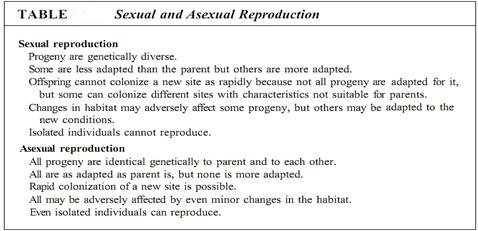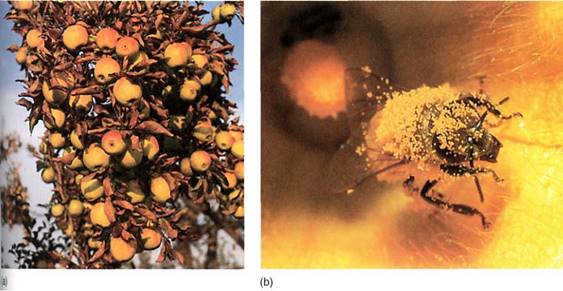


 النبات
النبات
 الحيوان
الحيوان
 الأحياء المجهرية
الأحياء المجهرية
 علم الأمراض
علم الأمراض
 التقانة الإحيائية
التقانة الإحيائية
 التقنية الحيوية المكروبية
التقنية الحيوية المكروبية
 التقنية الحياتية النانوية
التقنية الحياتية النانوية
 علم الأجنة
علم الأجنة
 الأحياء الجزيئي
الأحياء الجزيئي
 علم وظائف الأعضاء
علم وظائف الأعضاء
 الغدد
الغدد
 المضادات الحيوية
المضادات الحيوية|
Read More
Date: 9-11-2016
Date: 27-10-2016
Date: 6-11-2016
|
Introduction to Flowers Reproduction
Reproduction can serve two very different functions: (1) producing offspring that have identical copies of the parental genes, or (2) generating new individuals that are genetically different from the parents. Under certain environmental conditions, species that are genetically diverse survive better than genetically homogeneous species; under other conditions just the opposite is true. A plant that has been able to survive and grow to reproductive maturity is relatively well adapted to its location, so any progeny that are genetically identical to it are at least as well adapted as it is. Any progeny that are not genetically identical to the parent may or may not be well adapted to the conditions to which the parent is adapted.
If the environment is stable during several lifetimes, it is selectively advantageous for an organism to reproduce asexually by budding or sending out runners, thus producing new similarly adapted individuals. However, if the environment is not stable, such of spring may find themselves in conditions for which they are poorly adapted; if all are identical, all may die. Instability of the environment can result from many factors; for instance, landslides, avalanches, and road-building in forests kill existing vegetation, opening up new, sunny sites that are good for quickly growing, sun-loving weedy plants. Irregular climatic events, such as unusually severe freezes, droughts, floods, or hurricanes, also disrupt plant communities. If all members of a species are equally susceptible to low temperatures, all may be killed by a rare freeze. But if the species is genetically diverse, some individuals may survive. Even though most die, the few survivors may be sufficient to repopulate the site (Table ).

With asexual reproduction, progeny are never more fit than the parent, but during sexual reproduction sex cells of one plant combine with those of one or several others, resulting in many new gene combinations. Sex cells are so small that many can be produced by a single plant, and many new combinations of genes can be "tested" rather inexpensively. For example, a single large tree can produce thousands of flowers and millions of pollen grains, each genetically unique, yet the tree uses only a few grams of carbohydrate, protein, and minerals (Fig.1).

FIGURE 1 (a) :These apple fruits have developed from flowers, and the seeds inside the fruits developed from egg cells inside the flowers. All the egg cells produced by this tree have similar genes. But sperm cells were necessary to fertilize the eggs, and bees may have brought many types of sperm cells from many different apple trees. Although every seed here has the same maternal parent (the tree in the photo), it is possible that all the seeds have different paternal parents. The seeds are not genetically identical. (b) This bee is emerging from a squash flower, covered with pollen. As it visits tie next squash flower, it will accidentally leave some of this pollen there and pick up more pollen. In this process, genes are transferred from plant to plant. (William E. Ferguson).
Similarly, thousands of egg cells can be produced using only a small amount of resources. The pollen from one plant can be blown or carried by pollinators to the flowers of hundreds or thousands of other plants, and one plant may receive pollen from numerous other individuals. The thousands of seeds produced by a single sexually reproducing plant represent thousands of natural genetic experiments. During seed and fruit maturation, those embryos with severely mismatched genes abort and use no further resources. The tree finally produces hundreds or thousands of fruits and seeds. The total reproductive effort may be a significant drain on the tree's resources , but it Produces numerous embryos, many of which are at least as genetically fit as the tree is and perhaps even more fit.
As a further example, think of sexual reproduction in humans: The children produced by a particular couple are variable, not identical to each other or to either parent. Some of the children may have a particularly advantageous combination of genes and be more healthy or intelligent or athletic or creative than either parent. Others may have combinations of genes that result in congenital problems such that the children can survive only through medical help. Most children are more or less the same as the parents. The diversity is important.
Sexual reproduction also has negative aspects. Two individuals are required, and sex cells must move from one plant to another. In seed plants, pollen may be carried by wind, insects, and birds, but each results in the loss of many pollen grains or the need to produce nectar. Furthermore, potential sex partners may be widely scattered. For example, in a population of trees, those few individuals growing at the highest altitudes may have no neighbors, while those growing at lower altitudes have numerous close neighbors. The flowers of the highest individuals may receive no pollen and thus produce no seeds during some years. By contrast, plants that reproduce asexually can do so at any time, even when completely isolated. Some flowering plants are self-fertile and can undergo self-pollination, but they lose the benefit of receiving new genes from another plant.
Some plants reproduce both sexually and asexually. Strawberries have flowers and sexual reproduction involving genetically diverse embryos and seeds, but they also spread rapidly and asexually by runners. Bamboos are perennial grasses that flower and set seed only occasionally (in some species, only once every 80 years), but their rhizomes grow vigorously and establish many new plants asexually. Kalanchoes produce large numbers of seeds each year, but they also produce such large numbers of plantlets along their leaf margins that they can be weeds in both nature and in greenhouses (Fig. 2a).


FIGURE 2 (a) Kalanchoe plants are called maternity plants because they produce plantlets complete with stems, leaves, and roots along their leaf margins. Although hundreds of plantlets can be produced, all nuclear divisions are mitotic—duplication division—so all these plantlets are genetically identical to the parent; none is superior. (Jamss L. Castner) (b) Chollas, species of Opuntia, have branches only weakly attached to the trunk. If an animal brushes against a branch, the spines stick to the animal and the branch is pulled from the plant. After the animal dislodges the branch, it roots and grows into a new plant. Long-distance distribution almost as extensive as that of seeds can occur. (c) All the trees in this photograph are a part of the same plant, each a sprout from a single root system. The plant actually covers several acres: All the trees in the dense stands around the valley (d) are a single individual. (c and d, Courtesy of Michael Grant, University of Colorado)
Seeds, which are produced by sexual reproduction, often have a means of long-distance dispersal: Strawberries are eaten and the seeds later defecated; bamboo fruits and seeds are carried by winds. The consequence of this is that seeds may become widely scattered and germinate in numerous diverse sites, each site differing from the others in its microclimate, soil conditions, and exposure to predators and pathogens. Of course, a seed carrying an embryo with a combination of genes selectively advantageous for growth in a dry site may land in a wet site and not survive. But with the large numbers of seeds produced, it is statistically probable that some seeds will land in sites for which they are well suited.
In contrast, new plants that are produced asexually usually are not capable of long-distance dispersal; runners, rhizomes, and plantlets result in new plants that become established in the same microhabitat as their parent. Once a single plant becomes established in a suitable site, by reproducing asexually it can quickly fill the area with replicas of itself all of which are as fit as it is.



|
|
|
|
اكتشاف تأثير صحي مزدوج لتلوث الهواء على البالغين في منتصف العمر
|
|
|
|
|
|
|
زهور برية شائعة لتر ميم الأعصاب التالفة
|
|
|
|
|
|
موكب أهالي كربلاء يستذكر شهادة الإمام الصادق (عليه السلام)
|
|
|
|
العتبة العباسية تستذكر شهادة الإمام الصادق (عليه السلام) بإقامة مجلس عزاء
|
|
|
|
أهالي كربلاء يحيون ذكرى شهادة الإمام الصادق (عليه السلام) في مدينة الكاظمية
|
|
|
|
شعبة مدارس الكفيل النسوية تعقد اجتماعًا تحضيريًّا لوضع الأسئلة الامتحانية
|